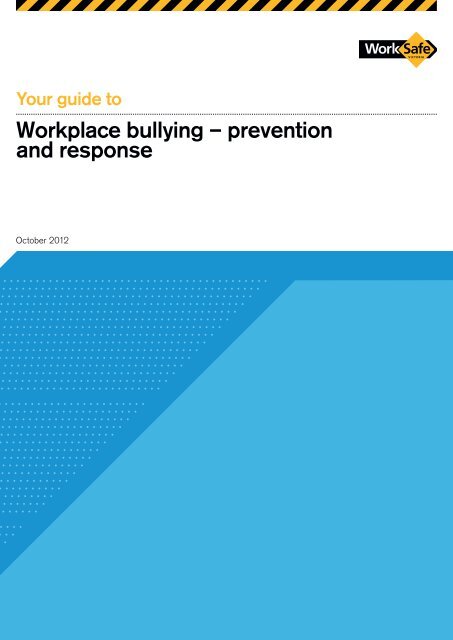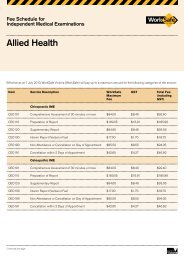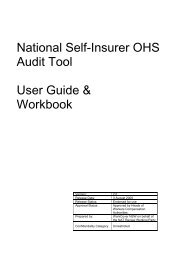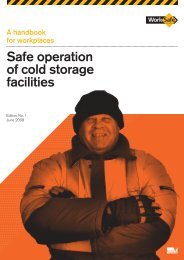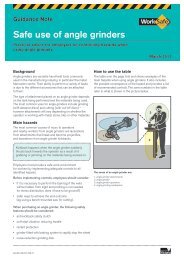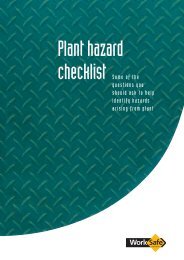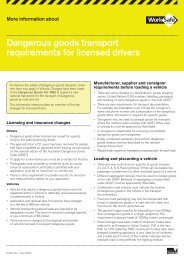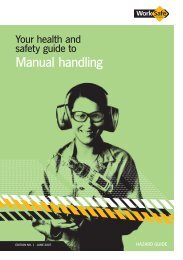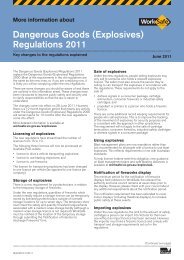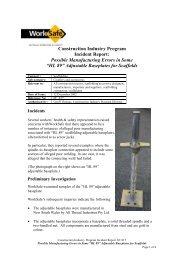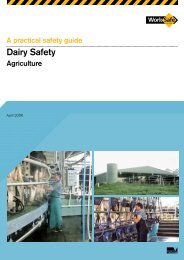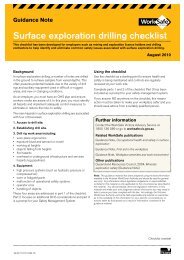Workplace bullying â prevention and response - WorkSafe Victoria
Workplace bullying â prevention and response - WorkSafe Victoria
Workplace bullying â prevention and response - WorkSafe Victoria
You also want an ePaper? Increase the reach of your titles
YUMPU automatically turns print PDFs into web optimized ePapers that Google loves.
Your guide to<strong>Workplace</strong> <strong>bullying</strong> – <strong>prevention</strong><strong>and</strong> <strong>response</strong>October 2012
Contents1. Introduction 12. <strong>Workplace</strong> <strong>bullying</strong> <strong>and</strong> OHS law 23. Prevention 33.1 Policies <strong>and</strong> procedures 33.2 Information, instruction, training <strong>and</strong> supervision 53.3 Monitor <strong>and</strong> review 74. Response 84.1 Early intervention 84.2 When <strong>and</strong> how to investigate 94.3 After an investigation 115. Further information 12
1.Introduction<strong>Workplace</strong> <strong>bullying</strong> can happen in any workplace. Under certain conditions, anyonecan be capable of <strong>bullying</strong> behaviour. It can have an impact on an individual’s health<strong>and</strong> affect their ability to do their job. It can also contribute to loss of productivity,staff turnover, absenteeism, low morale <strong>and</strong> financial costs.This guide provides information on how employers can implement measures toeliminate or reduce workplace <strong>bullying</strong>, so far as is reasonably practicable. It alsoprovides practical information for employers on what to do when an issue is raised.This information will help employers <strong>and</strong> employees comply with their duties underthe <strong>Victoria</strong>n Occupational Health <strong>and</strong> Safety Act 2004 (OHS Act). It can also beused by health <strong>and</strong> safety representatives (HSRs).The focus of this guide is preventing <strong>and</strong> responding to workplace <strong>bullying</strong> from anoccupational health <strong>and</strong> safety (OHS) perspective. <strong>Workplace</strong> <strong>bullying</strong> can be coveredby laws <strong>and</strong> agencies other than <strong>WorkSafe</strong> <strong>Victoria</strong>. Those agencies can also provideemployers <strong>and</strong> employees with advice <strong>and</strong> assistance (see chapter 5).Threats to harm someone, acts of violence, assault, property damage <strong>and</strong> stalkingare criminal matters that should be referred to the police. Responses at theworkplace should be appropriate to the seriousness of what has occurred.This guide is not intended to cover dissatisfaction or grievances with organisational<strong>and</strong> management practices or poor management practices on their own, as they arenot workplace <strong>bullying</strong>. At times people may feel that their working life is unpleasant<strong>and</strong> that they are being inappropriately treated, but feeling upset or undervalued atwork does not mean an individual is being bullied at work.<strong>WorkSafe</strong> <strong>Victoria</strong> Your guide to <strong>Workplace</strong> <strong>bullying</strong> – <strong>prevention</strong> <strong>and</strong> <strong>response</strong> 1
2. <strong>Workplace</strong><strong>bullying</strong> <strong>and</strong>OHS law<strong>Workplace</strong> <strong>bullying</strong> is characterised by persistent <strong>and</strong> repeated negativebehaviour directed at an employee that creates a risk to health <strong>and</strong> safety.OHS law places duties on employers to eliminate, so far as is reasonably practicable,risks to the health <strong>and</strong> safety of their employees. If it is not reasonably practicableto eliminate risks to health <strong>and</strong> safety, then an employer must reduce those risksso far as is reasonably practicable.OHS law places duties on employees to take reasonable care for the health <strong>and</strong>safety of persons who may be affected by their acts or omissions at a workplace<strong>and</strong> to cooperate with their employer’s actions taken to comply with the OHS Act.ConsultationOHS law requires employers to consult with, so far as is reasonably practicable,employees who are, or who are likely to be, directly affected by a health <strong>and</strong>safety matter.Health <strong>and</strong> safety matters requiring consultation include:• identifying or assessing hazards or risks arising from activities of the business• making decisions about the measures to be taken to control risks to healthor safety in the workplace.Consultation can assist employers implement <strong>prevention</strong> measures <strong>and</strong> raiseawareness in the workforce.!When can workplace <strong>bullying</strong> be an offence underOHS law?<strong>Workplace</strong> <strong>bullying</strong> may amount to a breach of the OHS Act where:• it has created a risk to an employee’s (or another person’s) health <strong>and</strong> safety,<strong>and</strong> the employer has failed to take all reasonably practicable steps to prevent<strong>and</strong> address it• an employee has acted in a way that fails to take reasonable care for thehealth <strong>and</strong> safety of others at a workplace.2 Your guide to <strong>Workplace</strong> <strong>bullying</strong> – <strong>prevention</strong> <strong>and</strong> <strong>response</strong> <strong>WorkSafe</strong> <strong>Victoria</strong>
3. PreventionEmployers have a duty underthe OHS Act to provide <strong>and</strong>maintain for its employees,so far as is reasonablypracticable, a workingenvironment that is safe<strong>and</strong> without risks to health.This includes providing <strong>and</strong>maintaining systems of workthat are, so far as isreasonably practicable, safe<strong>and</strong> without risks to health.Because there is a risk of workplace <strong>bullying</strong> wherever people work togetheremployers should implement all of the measures outlined in this section tocontrol the risk. When fully implemented in consultation with employees <strong>and</strong> HSRs(where they are in place), the measures in this section will help employers eliminateor reduce the risk of workplace <strong>bullying</strong> at their workplaces so far as isreasonably practicable.3.1 Policies <strong>and</strong> proceduresPolicies <strong>and</strong> procedures are a good starting point for preventing workplace <strong>bullying</strong>.Employers (in consultation with employees <strong>and</strong> HSRs) should develop <strong>and</strong>implement a workplace policy <strong>and</strong> a procedure for workplace <strong>bullying</strong>. Having anagreed procedure <strong>and</strong> a policy will assist an employer to take a consistent approachto resolving workplace <strong>bullying</strong>.Employers can set <strong>and</strong> enforce clear st<strong>and</strong>ards of behaviour for their employeesthrough workplace policies. A workplace policy sets the st<strong>and</strong>ards of behaviour at aworkplace <strong>and</strong> makes a clear statement that <strong>bullying</strong> behaviour will not be tolerated.<strong>Workplace</strong> procedures set out how issues will be dealt with if they are reported orcome to the attention of the employer (or their representative).<strong>Workplace</strong> policyA workplace policy sets out the st<strong>and</strong>ard of behaviour that needs to be followedat work. It can be drafted in a positive way such as outlining how everyone shouldbe treated at work or it can outline what people shouldn’t do.The workplace policy can be set in a number of areas such as through a st<strong>and</strong>-aloneworkplace <strong>bullying</strong> policy, an OHS policy, an anti-discrimination or equal opportunitypolicy, a code of conduct, or another policy on behaviour at work. Wherever theworkplace policy on workplace <strong>bullying</strong> is placed, employees must be consultedin its development.!What should be in a workplace policy?• commitment to providing employees with a safe working environment• the st<strong>and</strong>ard of behaviour that all employees are expected to comply with• where relevant, a statement that the policy includes communication through SMS,email <strong>and</strong> social media• what can happen if the policy is not complied with• how <strong>and</strong> where to report issues• where to get more information.<strong>WorkSafe</strong> <strong>Victoria</strong> Your guide to <strong>Workplace</strong> <strong>bullying</strong> – <strong>prevention</strong> <strong>and</strong> <strong>response</strong> 3
PreventionPromote the workplace policyThe workplace policy should be communicated <strong>and</strong> promoted through notice boards,team meetings, the intranet <strong>and</strong> by management regularly discussing the policy withtheir team/s. The policy should also be reinforced through training (see chapter 3.2).For small businesses the workplace policy can be promoted by talking about it.Policy checklistPolicy developed in consultation with employees/HSRs(where they are in place)Policy in place <strong>and</strong> communicated to all employeesPolicy is included in induction for new employeesPolicy is implemented business-widePolicy is discussed at team meetingsPolicy has a review dateEncourage reportingEmployees will be more likely to report workplace <strong>bullying</strong> if they have confidencein the workplace procedure <strong>and</strong> know it will be used when necessary.Encouraging reporting assists employers to:• take action to address the issues as early as possible• assess whether workplace <strong>bullying</strong> <strong>prevention</strong> measures are working• provide prompt assistance <strong>and</strong> support to employees.Reporting can be encouraged by:• consistent <strong>and</strong> effective <strong>response</strong>s to issues• supervisors <strong>and</strong> managers acting appropriately on issues when theybecome aware of them• regularly providing information (eg quarterly) to the health <strong>and</strong> safety committeeon numbers of reports made, how they were resolved <strong>and</strong> what actions were taken• regularly providing information to employees on numbers of reports made,how they were resolved <strong>and</strong> what actions were taken.4 Your guide to <strong>Workplace</strong> <strong>bullying</strong> – <strong>prevention</strong> <strong>and</strong> <strong>response</strong> <strong>WorkSafe</strong> <strong>Victoria</strong>
Prevention<strong>Workplace</strong> procedureTo assist employers with a consistent approach, <strong>WorkSafe</strong> <strong>Victoria</strong> recommendsdeveloping <strong>and</strong> implementing a set procedure for responding to workplace <strong>bullying</strong>.A workplace procedure should suit the size <strong>and</strong> structure of a business <strong>and</strong> bedeveloped in consultation with employees <strong>and</strong> HSRs. <strong>Workplace</strong> proceduresshould outline how issues will be dealt with (see chapter 4).<strong>Workplace</strong> procedure checklistProcedure developed in consultation with employees/HSRs(where they are in place)Procedure in place <strong>and</strong> communicated to all employeesEmployees know how <strong>and</strong> where to report workplace <strong>bullying</strong>Procedure is included in induction for new employeesProcedure has a review date3.2 Information, instruction, training <strong>and</strong> supervisionEmployers must also provide such information, instruction, training <strong>and</strong> supervision toemployees, as is necessary, to enable them to work in a way that is safe <strong>and</strong> withoutrisks to health. Employers should ensure employees underst<strong>and</strong> their role <strong>and</strong> havethe appropriate skills to do their job. This includes making sure that employees whosupervise others have appropriate skills <strong>and</strong>, if necessary, giving them training toget the skills before starting supervisory duties.InductionEmployers should ensure that information about workplace <strong>bullying</strong>, including anyrelevant policies <strong>and</strong> procedures, is included in new employee inductions. Inductionsshould cover the range of employees at the work-site (eg permanent employees,casuals, part-timers, shift workers, volunteers <strong>and</strong> labour hire workers).<strong>WorkSafe</strong> <strong>Victoria</strong> Your guide to <strong>Workplace</strong> <strong>bullying</strong> – <strong>prevention</strong> <strong>and</strong> <strong>response</strong> 5
Prevention<strong>Workplace</strong> <strong>bullying</strong> <strong>prevention</strong> trainingEmployers should train employees in the policy <strong>and</strong> procedure that applies toworkplace <strong>bullying</strong>. Information on how employees can manage an issue should alsobe included.Topics to cover in training include:• the workplace policy <strong>and</strong> how to comply with it• the workplace procedure <strong>and</strong> how to report• how to deal with workplace <strong>bullying</strong>• technology <strong>and</strong> workplace <strong>bullying</strong>.More specific training should be provided to the employees who have a role inthe workplace procedure (eg investigators, employer representatives, line managers<strong>and</strong> supervisors). That training should provide participants with the skills they needto perform their role in the procedure <strong>and</strong> how <strong>and</strong> when to directly intervenein a situation.Employers should ensure the person who is their representative in resolvingOHS issues when they are raised, is also able to deal with workplace <strong>bullying</strong>.SupervisionLine managers <strong>and</strong> supervisors should know what to do if an issue is reported tothem or they become aware of a problem in their work group. Supervisors shouldknow how to recognise <strong>and</strong> act on workplace <strong>bullying</strong> <strong>and</strong> demonstrate positivebehaviour. Supervisors should be provided with ongoing training on managingperformance <strong>and</strong> providing feedback.Induction, training <strong>and</strong> supervision checklistAll new employees receive induction on workplace <strong>bullying</strong> policy<strong>and</strong> procedureSupervisors <strong>and</strong> line managers have been trained in responding to reportsSupervisors monitor their workgroups for signs of workplace <strong>bullying</strong>Supervisors are trained in managing employees performanceSupervisors are trained in providing feedback6 Your guide to <strong>Workplace</strong> <strong>bullying</strong> – <strong>prevention</strong> <strong>and</strong> <strong>response</strong> <strong>WorkSafe</strong> <strong>Victoria</strong>
Prevention3.3 Monitor <strong>and</strong> reviewMonitoring can be done through regular scheduled discussion at managementmeetings, board meetings, staff meetings, <strong>and</strong> health <strong>and</strong> safety committeemeetings. The aim of monitoring is to check that <strong>prevention</strong> measures arestill working <strong>and</strong> implement new measures if needed.It is not enough for an employer to just establish a safe system of work– they must also maintain the system <strong>and</strong> ensure it is complied with.Monitoring workplace <strong>prevention</strong> measures can help an employer checktheir safe system of work is being maintained.A review of the policy <strong>and</strong> procedures should be done regularly (eg every 12months). While it can be done anytime, <strong>WorkSafe</strong> recommends employers havea planned approach that involves consulting employees <strong>and</strong> HSRs. Reviewingthe workplace policy <strong>and</strong>/or procedure can help educate <strong>and</strong> engage employees.Results of reviews <strong>and</strong> suggested improvements/recommendations should bereported to health <strong>and</strong> safety committees, HSRs, senior leadership <strong>and</strong> the boardof management.Monitoring <strong>and</strong> review checklistClear st<strong>and</strong>ards of behaviour are set, communicated <strong>and</strong> enforcedAll employees (including supervisors <strong>and</strong> managers)know the st<strong>and</strong>ards of behaviour <strong>and</strong> follow themNew employees are inductedTraining is providedProcedures for dealing with workplace <strong>bullying</strong> are in placeProcedures allow for early intervention <strong>and</strong> formal investigationSupervisors know what to do if it is reported <strong>and</strong> know how to act on<strong>bullying</strong> behaviour<strong>WorkSafe</strong> <strong>Victoria</strong> Your guide to <strong>Workplace</strong> <strong>bullying</strong> – <strong>prevention</strong> <strong>and</strong> <strong>response</strong> 7
4.ResponseLike other OHS risks, workplace <strong>bullying</strong> is best managed by dealing with itas soon as an employer is aware there is a problem. An employer’s failure toprevent or address workplace <strong>bullying</strong> may contribute to a working environmentthat creates a risk to health <strong>and</strong> safety.Act promptly – as soon as an employer is aware of behaviours that may beworkplace <strong>bullying</strong> then they should take action.<strong>Workplace</strong> <strong>bullying</strong> may be raised with an employer in a number of ways, including:• a written or verbal report• directly observing behaviour• an HSR raising an issue for a member of their designated work groups (DWG)or the whole DWG• a workers’ compensation claim being made• being told about an individual using an early intervention approach.Effectively responding to issues when they are raised can stop the situationhappening again <strong>and</strong> reinforce for employees that workplace <strong>bullying</strong> is dealt withseriously by their employer. Effective <strong>response</strong> involves selecting an approach todeal with the issue, either through early intervention or a formal investigation.Early intervention usually suits situations where behaviour may have just occurred orhas not escalated. Formal investigation should be used for serious allegations.4.1 Early interventionEarly intervention is a way of solving an issue without a formal report, investigationor discipline being taken against an individual. Early intervention can be achievedthrough an individual self-managing a situation or seeking help from someone elseto raise the issue. Generally, employers should encourage self-management as afirst step to resolve an issue.8 Your guide to <strong>Workplace</strong> <strong>bullying</strong> – <strong>prevention</strong> <strong>and</strong> <strong>response</strong> <strong>WorkSafe</strong> <strong>Victoria</strong>
ResponseSelf-managing an issueSelf-management is an informal approach to address workplace <strong>bullying</strong>. It involvesthe individual who experiences the negative behaviour directly telling the otherperson that the behaviour is not welcome <strong>and</strong> it should not happen again. It shouldbe done in a calm <strong>and</strong> professional way (eg telling the person about the impact ofthe behaviour <strong>and</strong> asking them not to do it again). If the behaviour continues orgets worse then a formal report should be made.If an individual doesn’t feel confident enough to manage a situation themselves,the issue can be raised through another person. This includes:• a supervisor or manager• the other employee’s supervisor or manager• an HSR• human resources department.Anyone asked to act on behalf of an individual should use a confidential <strong>and</strong>non-confrontational approach when discussing the issue.Supervisors, line managers <strong>and</strong> early interventionSupervisors <strong>and</strong> line managers should intervene in issues they directly observe intheir workgroups or if they are requested to intervene by a member of their team.If a supervisor or manager approaches an individual directly about their behaviourthey should record the action/s taken. Supervisors should know how <strong>and</strong> whenit is appropriate to escalate an issue.HSRs <strong>and</strong> early interventionHSRs can raise issues on behalf of their DWG. They can also give advice tomembers of their DWG on how to approach an issue.4.2 When <strong>and</strong> how to investigateThe aim of investigation is to work out what happened <strong>and</strong> what the appropriatecourse of action is. Where a serious allegation has been made, an investigationshould be the first step taken. An investigation should be used:• for reports that cover a long period of time• for reports that include threats• for reports against a number of employees• when an early intervention approach has not addressed the issue.<strong>WorkSafe</strong> <strong>Victoria</strong> Your guide to <strong>Workplace</strong> <strong>bullying</strong> – <strong>prevention</strong> <strong>and</strong> <strong>response</strong> 9
ResponseHow to investigateAppoint an impartial <strong>and</strong> experienced person (someone neutral to all partiesinvolved who has no conflicts of interest) to investigate. That person should:– set the scope of the investigation by determining what allegations will be tested– set the process (who will be interviewed, when, <strong>and</strong> how long it should take etc).Use an experienced external investigator to undertake the investigation when:• there is no suitably skilled person available at the workplace• a suitably skilled person has a conflict of interest.The person conducting the investigation should:• treat all matters being investigated seriously <strong>and</strong> confidentially• examine matters impartially <strong>and</strong> in a timely way• allow for appropriate time• identify <strong>and</strong> speak to relevant witnesses• inform everyone involved of the possible investigation results <strong>and</strong> outcomes• assess reports on their merits <strong>and</strong> facts• hear parties separately (versions of what allegedly happened may differ)• record the facts surrounding the matter.To ensure the investigation process is conducted in a fair, objective <strong>and</strong> timely way,it is important to ensure the respondent:• is fully informed of all allegations against them• is fully informed about the investigation process <strong>and</strong> possible outcomes(eg disciplinary action)• has an opportunity to seek independent advice <strong>and</strong> representation• is given full opportunity to reply to the complaint/s• has their confidentiality maintained• is informed how they can seek a review of a decision.At the end of an investigation, the person investigating should submit anobjective report that:• describes the allegations/what was reported• describes the investigation processes• outlines all relevant evidence (including who was interviewed)• concludes whether workplace <strong>bullying</strong> can or cannot be substantiatedThe report should be acted on <strong>and</strong> its key findings communicated in a sensitiveway to the complainant <strong>and</strong> respondent.10 Your guide to <strong>Workplace</strong> <strong>bullying</strong> – <strong>prevention</strong> <strong>and</strong> <strong>response</strong> <strong>WorkSafe</strong> <strong>Victoria</strong>
Response4.3 After an investigationWhere an investigation has substantiated that workplace <strong>bullying</strong> occurred,recommendations should be made on the actions that will be taken to finalisethe matter (eg actions to assist resolution, ways to improve <strong>response</strong> proceduresin the future). In some circumstances, an investigation may find that a report ofworkplace <strong>bullying</strong> cannot be substantiated <strong>and</strong> no further action can be taken.Communicate recommendations to relevant people (eg the complainant, therespondent <strong>and</strong> other relevant parties). Where appropriate, recommendations forimprovements should also be communicated to HSRs (where in place), the OHScommittee <strong>and</strong> employees.The options used to resolve a substantiated complaint will vary according to thenature of the situation <strong>and</strong> on a case-by-case basis. Actions taken to resolvecomplaints are outlined below. Note: these actions can be combined, <strong>and</strong> takenat both the individual <strong>and</strong> organisational level.Organisational level• run an awareness session• run training sessions(eg communication skills, conflictmanagement, interpersonal skills.This can be for one person, aworkgroup or section ororganisation-wide• ongoing monitoring of the affectedwork group• review the workplace policy withemployees <strong>and</strong> managers orworkgroups• review the workplace <strong>prevention</strong>measures• review workplace procedures <strong>and</strong>improve the process in consultationwith employees.Individual level• direct an employee to stop thebehaviour• invite an apology• individual training• provide mediation or other disputeresolution process• coach, counsel <strong>and</strong>/or mentoran employee/s• use disciplinary action.<strong>WorkSafe</strong> <strong>Victoria</strong> Your guide to <strong>Workplace</strong> <strong>bullying</strong> – <strong>prevention</strong> <strong>and</strong> <strong>response</strong> 11
5. FurtherinformationFair Work Ombudsman131394fairwork.gov.auThe role of the Fair Work Ombudsman is to work with employees, employers,contractors <strong>and</strong> the community to promote harmonious, productive <strong>and</strong>cooperative workplaces. They investigate workplace complaints <strong>and</strong>enforce compliance with Australia’s workplace laws.<strong>Victoria</strong>n Equal Opportunity <strong>and</strong> Human RightsCommission1300 292 159humanrightscommission.vic.gov.auProvide a range of training programs <strong>and</strong> resources for employers <strong>and</strong> employeeson anti-discrimination law <strong>and</strong> good employment practices. Many of these includea focus on workplace <strong>bullying</strong>.<strong>Victoria</strong> PoliceMatters involving allegations of assault, damage to property, sexual assault<strong>and</strong> stalking should be referred to the police.Unions <strong>and</strong> industry associationsMembers of unions or industry associations can contact those organisationsfor advice <strong>and</strong> assistance in relation to workplace <strong>bullying</strong>.<strong>WorkSafe</strong> <strong>Victoria</strong>1800 136 089worksafe.vic.gov.au/<strong>bullying</strong>Can provide information about what to expect from <strong>WorkSafe</strong>.12 Your guide to <strong>Workplace</strong> <strong>bullying</strong> – <strong>prevention</strong> <strong>and</strong> <strong>response</strong> <strong>WorkSafe</strong> <strong>Victoria</strong>
<strong>WorkSafe</strong> <strong>Victoria</strong><strong>WorkSafe</strong> AgentsAgent contact details are all available atworksafe.vic.gov.au/agentsAdvisory ServicePhone (03) 9641 1444Toll-free 1800 136 089Email info@worksafe.vic.gov.auHead Office222 Exhibition Street, Melbourne 3000Phone (03) 9641 1555Toll-free 1800 136 089Website worksafe.vic.gov.auFor information about <strong>WorkSafe</strong> inyour own language, call our Talking yourLanguage service1300 559 1411300 650 5351300 661 4941300 660 2101300 662 3731300 722 5951300 724 1011300 725 4451300 781 8681300 554 9871300 782 4421300 782 343WSV1545/01/10.12


